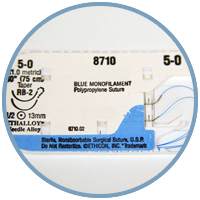Knot Security: Suture Characteristics
Suture Characteristics
Monofilament Sutures
Monofilament suture materials possess greater memory (i.e., suture tendency to retain its shape after it is manufactured) than multifilament suture. Monofilament also has a lower coefficient of friction (i.e., more slippery) than multifilament materials. These characteristics have a direct impact on knot security. The security of the knot made with monofilament materials is associated with how it is formed (e.g., square versus granny) and also with how the round suture shape changes as it is tensioned. This change in shape is called "plastic deformation".

Pack of monofilament sutures
The round shape becomes somewhat flattened and creased when deformed, locking the suture strands together, which resists untying or loosening. To lock monofilament sutures, they must be snugged down and pulled tightly together to deform the shape of the suture within the knot. The surgeon will know that the knot has undergone plastic deformation and is secure when there is no tendency for the spaces between the throws to open after tension on the strands is released. Therefore, when using monofilament suture, surgeons should strive to see no "daylight" between the throws of their knots.
Keep in mind that the stiffer the suture and the larger the size of monofilament suture, the more tension is required on the strands to adequately deform the suture and secure the knot. This plastic deformation is similar to what happens to a plastic water container when it is crushed rather than being squeezed. The original shape of the container is maintained when it is gently squeezed, but it is permanently misshapen when it is crushed. Similarly, the thicker the suture, the harder it is to plastically deform, in much the same way as plastic gallon milk containers are much more difficult to permanently deform when compared to thin plastic water bottles.

The left photo shows an example of a knot tied using monofilament with correct tension.
The right photo is a knot that shows daylight between the throws, caused by exerting insufficient tension.
Multifilament Sutures

Pack of multifilament sutures
Multifilament suture such as silk, polyester, and chromic catgut possess a higher coefficient of friction on their surfaces than monofilament suture. Multifilament sutures generally tie and handle better than their monofilament counterparts due to their supple, flexible character.
Friction is the main mechanism responsible for knot security with multi-stranded suture materials. In some cases, a coating is applied to braided suture materials to facilitate its passage through tissue and to improve handling properties. However, the slippery nature of the coating often worsens the suture's knot security. To compensate for this characteristic, coated polyglycolic acid or polyglactin 910 (both commonly used braided synthetic absorbable sutures) require additional throws to form secure knots, whereas these same sutures supplied without coating can require fewer throws. However, not all suture coatings reduce knot security; some absorbable coatings dissolve quickly and reveal the underlying rough substrate surface, which enhances friction between the strands.
As a general rule, multifilament sutures become secure with considerably less tension applied to the strands when compared to monofilament sutures. However, all sutures must be knotted snuggly and squarely to be confidently secure.
